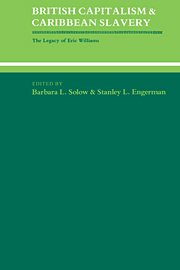Book contents
- Frontmatter
- Contents
- List of Contributors
- Preface
- British Capitalism and Caribbean Slavery: The Legacy of Eric Williams: An Introduction
- Part I Slavery as an Economic Phenomenon
- Part II Caribbean Slavery and the Industrial Revolution
- Part III The Decline of the British West Indies
- The American Revolution and the British West Indies' Economy
- “Dreadful Idlers” in the Cane Fields: The Slave Labor Pattern on a Jamaican Sugar Estate, 1762–1831
- Part IV The Basis of Abolition and Emancipation
- Part V Capitalism and Slavery in Historical Perspective
“Dreadful Idlers” in the Cane Fields: The Slave Labor Pattern on a Jamaican Sugar Estate, 1762–1831
Published online by Cambridge University Press: 15 December 2009
- Frontmatter
- Contents
- List of Contributors
- Preface
- British Capitalism and Caribbean Slavery: The Legacy of Eric Williams: An Introduction
- Part I Slavery as an Economic Phenomenon
- Part II Caribbean Slavery and the Industrial Revolution
- Part III The Decline of the British West Indies
- The American Revolution and the British West Indies' Economy
- “Dreadful Idlers” in the Cane Fields: The Slave Labor Pattern on a Jamaican Sugar Estate, 1762–1831
- Part IV The Basis of Abolition and Emancipation
- Part V Capitalism and Slavery in Historical Perspective
Summary
Ever since Curtin published his seminal study of The Atlantic Slave Trade, in which he pointed out the glaring disparity between the massive traffic to the Caribbean and the marginal traffic to North America, historians have been trying to explain the sharp demographic contrast between the two regions. Why did the slaves imported to the West Indian sugar islands die faster than they propagated, while the slaves imported to North America experienced marked natural increase? Four features of the Caribbean slave system are now commonly emphasized: the lethal disease environment, the high proportion of African-born slaves with low fertility, the inadequate slave diet, and the brutal and exploitive labor regimen.
This essay focuses on the last of these factors, and discusses the impact of the Caribbean labor routine upon the enslaved cane workers. My framework was established by Higman, who has used the British slave registration records of 1813 to 1834 to analyze the overall labor pattern in the British West Indian sugar islands during the closing generation of Caribbean slavery, and my methodology is borrowed from Craton, who has used the detailed plantation records at Worthy Park estate in Jamaica to present the first microcosmic account of a Caribbean slave gang in action. Like Craton, I have been scrutinizing the records of a particularly well-documented Jamaican sugar plantation: Mesopotamia estate in the western parish of Westmoreland.
- Type
- Chapter
- Information
- British Capitalism and Caribbean SlaveryThe Legacy of Eric Williams, pp. 163 - 190Publisher: Cambridge University PressPrint publication year: 1988
- 2
- Cited by

